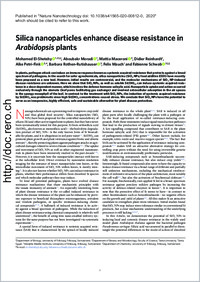Silica nanoparticles enhance disease resistance in Arabidopsis plants
- El-Shetehy, Mohamed Department of Biology, University of Fribourg, Fribourg, Switzerland - Department of Botany and Microbiology, Faculty of Science, Tanta University, Tanta, Egypt
- Moradi, Aboubakr Department of Biology, University of Fribourg, Fribourg, Switzerland
- Maceroni, Mattia Adolphe Merkle Institute, University of Fribourg, Fribourg, Switzerland
- Reinhardt, Didier Department of Biology, University of Fribourg, Fribourg, Switzerland
- Petri-Fink, Alke Adolphe Merkle Institute, University of Fribourg, Fribourg, Switzerland - Department of Chemistry, University of Fribourg, Fribourg, Switzerland
- Rothen-Rutishauser, Barbara Adolphe Merkle Institute, University of Fribourg, Fribourg, Switzerland
- Mauch, Felix Department of Biology, University of Fribourg, Fribourg, Switzerland
- Schwab, Fabienne Adolphe Merkle Institute, University of Fribourg, Fribourg, Switzerland
- 14.12.2020
Published in:
- Nature Nanotechnology. - 2021, vol. 16, p. 344-353
English
In plants, pathogen attack can induce an immune response known as systemic acquired resistance that protects against a broad spectrum of pathogens. In the search for safer agrochemicals, silica nanoparticles (SiO2 NPs; food additive E551) have recently been proposed as a new tool. However, initial results are controversial, and the molecular mechanisms of SiO2 NP-induced disease resistance are unknown. Here we show that SiO2 NPs, as well as soluble Si(OH)4, can induce systemic acquired resistance in a dose-dependent manner, which involves the defence hormone salicylic acid. Nanoparticle uptake and action occurred exclusively through the stomata (leaf pores facilitating gas exchange) and involved extracellular adsorption in the air spaces in the spongy mesophyll of the leaf. In contrast to the treatment with SiO2 NPs, the induction of systemic acquired resistance by Si(OH)4 was problematic since high Si(OH)4 concentrations caused stress. We conclude that SiO2 NPs have the potential to serve as an inexpensive, highly efficient, safe and sustainable alternative for plant disease protection.
- Faculty
- Faculté des sciences et de médecine
- Department
- Département de Biologie, AMI - Bio-Nanomatériaux
- Language
-
- English
- Classification
- Biological sciences
- License
- License undefined
- Identifiers
-
- RERO DOC 329898
- DOI 10.1038/s41565-020-00812-0
- Persistent URL
- https://folia.unifr.ch/unifr/documents/309092
Other files
Statistics
Document views: 104
File downloads:
- fin_sne.pdf: 378
- fin_sne_sm.pdf: 215

